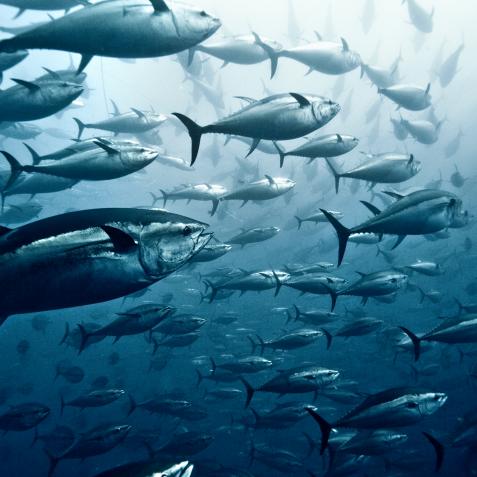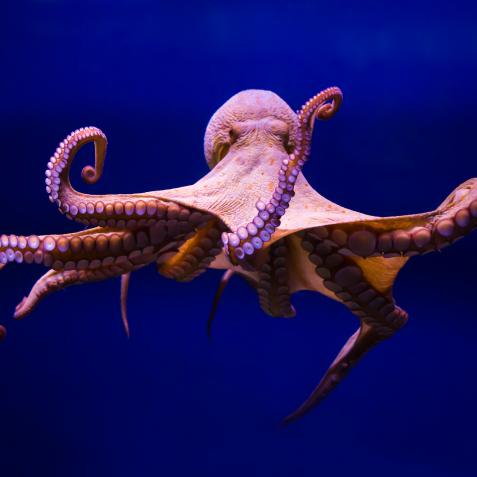.JPG.rend.hgtvcom.616.616.suffix/1591739192725.jpeg)
S. Flynn, The Namibian Dolphin Project
Underwater Noise Pollution Strikes the Wrong Chord
Meet Morgan J. Martin, PhD, a marine scientist who studies underwater sounds with whales, dolphins, and porpoises. Morgan observes how these marine creatures – also known as cetaceans – many of which navigate their underwater habitats through echolocation.
Echolocation, also called biosonar, is the ability to use sound to interpret surroundings. These animals emit sonar pulses out into their environment and listen as the sounds return from various objects near them. Morgan studies how whales, dolphins, and porpoises use this sonar technique to travel, hunt, and communicate with each other.

The Harmony of Underwater Acoustics
Morgan’s research helps us understand how these complex marine mammals live and thrive in the ocean. It also warns of the potentially disruptive and threatening consequences of ocean noise pollution to their way of life.
As part of The Explorers Club's World Oceans Week programming, Discovery got a chance to speak with Morgan who’s currently working as a postdoctoral researcher at the University of Victoria, in British Columbia, Canada on a bowhead whale tagging project to understand how shipping noise causes individual whale disturbance.
Q: How did you get into studying underwater acoustics?
A: I am from the land-locked town of Springfield, Illinois and I dreamed of working with marine mammals ever since I visited Florida and discovered dolphins at age seven. I’m grateful that my passion has never waned and it’s taken me on some wonderous adventures.
Morgan Martin and the Underwater Acoustics 6 Photos
Doesn't that sound like the cooleset band ever? Meet Morgan J. Martin, PhD, a marine scientist who studies underwater sounds with whales, dolphins, and porpoises.
After I received my master’s degree in marine science from the University of San Diego, I focused on studying cetaceans through volunteer work. I participated in offshore cetacean abundance (population sizes) research with the National Oceanic and Atmosphere Administration (NOAA) in California, Oregon, and Washington. Then I volunteered for a survey trip to Borneo, Indonesia to estimate cetacean abundance. It was fascinating that the same methods to study these mammals could be applied in very different ocean situations and from very different boats.
Q: Where else have your studies taken you?
My work has taken me all over the world and I’m fortunate to have studied some incredible marine environments. My PhD research took me to Cape Town, South Africa to learn from two cetacean scientists Dr. Tess Gridley and Dr. Simon Elwen. From there, my studies have transported me to places like Namibia, Denmark, and Antarctica.

Morgan Martin
This photo was taken off Borneo, Indonesia. I volunteered to work as a marine mammal observer for two weeks out of this small wooden boat. Species Featured: Bottlenose Dolphin
Q: Dolphins in Namibia? Tell us more!
Namibia is a global cetacean hotspot – around 33 species of cetaceans can be found just off its coast.
I worked with a small team of marine mammal researchers from the Namibian Dolphin Project to study different species of cetaceans off their coast.
For part of my PhD research, I used a kayak and suspended hydrophones (underwater microphones) into the water below and recorded the sounds of Heaviside’s dolphins, a species native to Namibia, while I witnessed their corresponding behaviors.
Q: Can dolphins talk to each other?
Yes, of course! My findings in Namibia showed that Heaviside’s dolphins produce two distinct types of echolocation clicks.
One click is extremely ultrasonic and used for navigating and hunting – and it cannot be heard by killer whales, dolphins’ only predators. Their second click is a lower frequency sound wave and can travel further underwater, which is more effective for communication, but is also risky for them to produce because it is able to be heard by killer whales.
My team and I concluded that Heaviside’s dolphins were able to use clicks of different frequencies for finding food and for communication. These dolphins are the first species known to do that!
I’ve now just begun a postdoctoral position and will be working on a conservation project for bowhead whales.
Q: What is a bowhead whale?
A: Bowhead whales are a magnificent species of the baleen family, they’re also among the oldest-living animals on earth. Scientists estimate the life-span of these Artic mammals can be over 200 years! Bowhead whales grow to about 50-60 feet and are capable of breaking through sea ice with their large skulls and powerful bodies.
For this project, we’re assessing how ocean noise pollution can cause disturbances to their population in the Canadian Arctic. To do this, we’ll mark the whales with acoustic recording tags that will help us track and determine how they react to various noises, including shipping commotion.
Q: What are the causes of ocean noise pollution?
Ocean noise is the combination of sounds from naturally occurring things like rain, wind, and seismic shifts but it also includes human activities such as shipping, navy sonar, and marine construction. As with humans, loud or constant sounds can cause hearing damage in marine creatures. Hearing injuries can be detrimental to many cetaceans that depend on sound to live.
There are also non-physical injuries that have severe long-term consequences. Large baleen whales are known to have the best hearing ranges at low frequencies, which is often used for methods of communication. However, this tends to overlap in the same frequency range as noise from large ships like container vessels, tankers and cruise ships. We call this 'acoustic masking'.

Dr. Simon Elwen, The Namibian Dolphin Project
Heaviside’s and dusky dolphins are the two most commonly seen cetacean species off the coast of Namibia. Dusky dolphins are known for their extreme acrobatics and can form groups of over 500 individuals.
Q: What happens during acoustic masking?
For cetaceans, acoustic masking is a term we use when a sound (often noise from human-generated sounds) interrupt marine mammal communication. For example, if an adult whale and its calf become separated and are unable to hear one another's contact calls it could lead to the pair becoming permanently separated.
Marine mammals also commonly use underwater sounds to attract a mate. If acoustic masking is present, the species will likely be less successful in their breeding efforts.
Acoustic masking could lead to migration disruption, population decline and even block the chatter of the seas’ most intelligent creatures.
Q: It sounds like oceans are getting louder, in a bad way. What can we do?
Sound levels in the oceans are constantly rising because of the man-made cacophony of ship traffic, navy sonar, and blasts from marine construction.
We must continue to monitor and study the health and abundance of local marine populations to understand the various effects of noise pollution and apply marine laws to mitigate ear-battering sounds and protect these intricate ecosystems.
This article was written in partnership with The Explorers Club. Hear more stories from explorers during World Oceans Week, June 7 - 12.









.jpg.rend.hgtvcom.336.252.suffix/1591739188387.jpeg)










